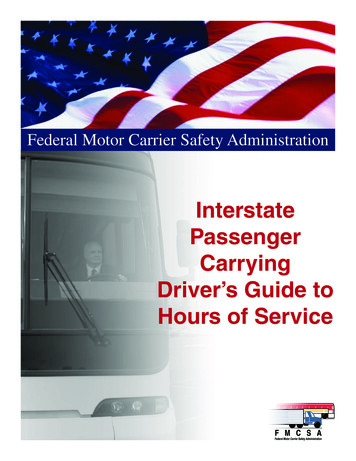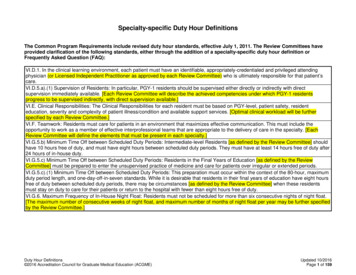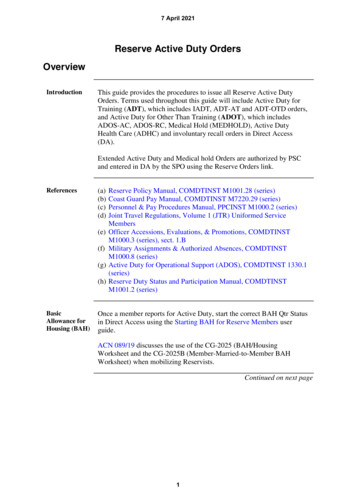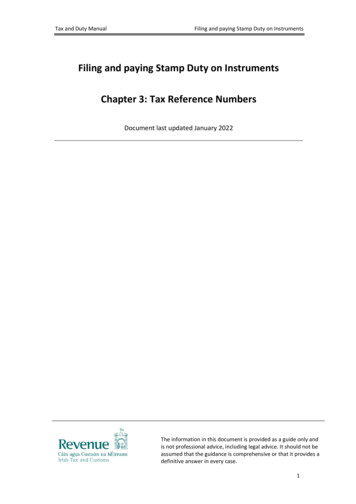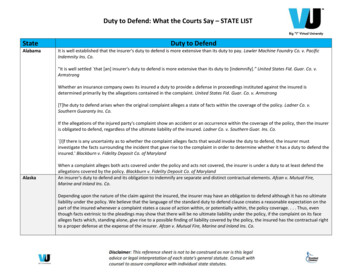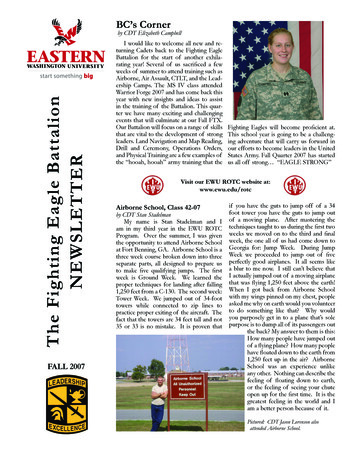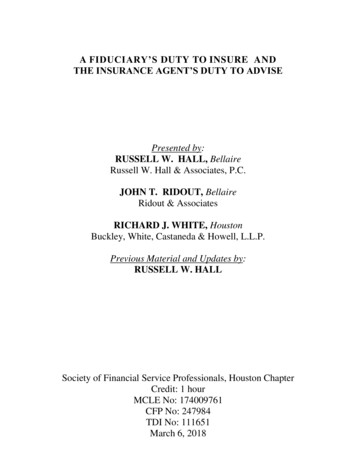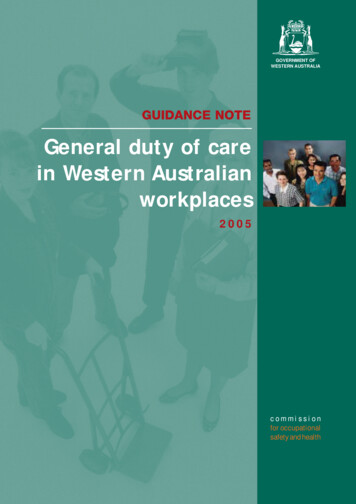
Transcription
GOVERNMENT OFWESTERN AUSTRALIAGUIDANCE NOTEGeneral duty of carein Western Australianworkplaces2005commissionfor occupationalsafety and health
2005
ForewordThe Occupational Safety and Health Act 1984 established the Commission for OccupationalSafety and Health, which comprises representatives of employers, unions, governmentand experts. The Commission has the function of developing the legislation and supportingguidance material and making recommendations to the Minister for implementation. To fulfilits functions, the Commission is empowered to establish advisory committees, hold publicenquiries and publish and disseminate information.The Commission’s objective is to promote comprehensive and practical preventative strategiesthat improve the working environment of Western Australians.This guidance note has been developed through this tripartite consultative process, and theviews of employers and unions along with those of government have been considered.The following information is provided as background to understanding this guidance note.The ActThe Occupational Safety and Health Act 1984 provides for the promotion, co-ordination,administration and enforcement of occupational safety and health in Western Australia.With the objective of preventing occupational injuries and diseases, the Act places certainduties on employers, employees, self-employed persons, manufacturers, designers, importersand suppliers.In addition to the broad duties established by the Act, it is supported by a further tier of statute,commonly referred to as regulations, together with lower tiers of non-statutory codes ofpractice and guidance notes.RegulationsRegulations have the effect of spelling out the specific requirements of the legislation.Regulations may prescribe minimum standards. They may have a general application or theymay define specific requirements related to a particular hazard or a particular type of work.Regulations may also be for the licensing or granting of approvals, certificates, etc.Codes of practiceA code of practice is defined in the Act as a document prepared for the purpose of providingpractical guidance on acceptable ways of achieving compliance with statutory duties andregulatory requirements.ii should be followed, unless there is another solution which achieves the same or betterresult; and can be used to support prosecution for non-compliance.
Guidance notesA guidance note is an explanatory document issued by the Commission providing detailedinformation on the requirements of legislation, regulations, standards, codes of practice ormatters relating to occupational safety and health.DisclaimerInformation in this publication is provided to assist you in meeting your occupational safety andhealth obligations. While information is correct at the time of publication, readers should checkand verify any legislation reproduced in this publication to ensure it is current at the time ofuse.Changes in law after this document is published may impact on the accuracy of information.The Commission for Occupational Safety and Health provides this information as a serviceto the community. The information and advice provided is made available in good faith and isderived from sources believed to be reliable and accurate at the time of publication.AuthorityIssued by the Commission for Occupational Safety and Health under the Occupational Safetyand Health Act 1984.PurposeTo explain the general duty in sections 19, 20, 21, 22 and 23 of the Occupational Safety andHealth Act 1984.ApplicationTo be read in conjunction with the Occupational Safety and Health Act 1984; and theOccupational Safety and Health Regulations 1996.iii
PrefaceThis guidance note provides information and assistance to employers and employees onthe ‘general duty of care’ provisions of the Western Australian Occupational Safety andHealth Act 1984.The duty of care provisions of the Occupational Safety and Health Act 1984 are thestarting point from which all other safety and health measures begin. This guidance noteexplains and clarifies the scope of the duties of care in the Act to assist people at work tounderstand their responsibilities.All parties in a workplace – employers, employees and self-employed persons – havesome responsibility for the safety and health of those at the workplace.This duty of care also extends to those who control workplaces, design and constructbuildings or manufacture and supply plant.Better understanding of the laws helps everyone in the workplace contribute towardsachieving a safe and healthy workplace environment.Guidance notes are developed within the tripartite setting of the Commissionfor Occupational Safety and Health, with input from representatives of employerorganisations, trade unions and the State Government.The development process is also an example of the State Government’s belief thatemployers and employees should work together to determine practical ways of improvingthe work environment.This guidance note has been approved for use in Western Australian workplaces.iv
ContentsIntroduction.1Achieving the objects of the Act . 3The legislative framework in Western Australia. 4The general duties.5An overview. 5Similarity to common law. 7The ‘reasonable person’. 8The meaning of ‘practicable’. 9Health as well as safety. 11The general duties and regulations. 11Working without regulations. 13Codes of practice. 14The general duties and standards. 16Standards not referred to in regulations. 16Workplaces covered by the general duties. 17A matter of control. 17Overlapping obligations. 18Duties of employers (towards their employees).19Meaning of ‘employer’. 20State government agencies. 20Safety and health policies. 21Other duties. 21Employer’s duty: basic principle. 22Working environment. 22Particular duties. 22Safe systems of work. 22Foreseeability. 24Identification of hazards, assessment and control. 25Information, instruction, training and supervision. 26Consultation and co-operation. 32Workplace policies and procedures. 33Safety and health representatives. 33Working together. 34Provision of personal protective clothing and equipment. 34Safe plant and substances. 36Monitoring exposure to hazards. 37Reporting of injuries and diseases. 37Duties of employees.38Meaning of ‘employee’. 39Employee’s general duty: basic duty. 39The extent of the duty. 40Particular duties. 40v
Contractors, sub-contractors, labour hire and other alternative working arrangements.42Contractors and sub-contractors. 42Premises. 43A matter of control. 43Labour hire arrangements. 44Other labour arrangements. 45Reporting requirements.46Reporting of injuries and diseases to the Commissioner. 46Notification of hazard to person having control of workplace. 47Duties of employers and self-employed persons (towards themselves and others).48Duties of employers and self-employed persons: basic principle. 49Protecting non-employees. 49Protecting an employee’s family. 50Duties of employers to maintain safe premises.51Duties placed on certain bodies corporate.52Duties of persons who have control of workplaces.53Duties of persons who have control of a workplace: basic principle. 54A matter of control. 55Written contracts. 55Premises covered. 55Safe entry and exit. 55Duties of manufacturers, suppliers and others.56Safe use of plant. 57Duties of erectors and installers. 58Substances at workplaces. 58Information on safety and health. 59Short and long term effects. 59Material safety data sheets. 59Adequate information that is up to date. 59Who provides the information?. 60Safe buildings and structures. 60Offences and penalties.61General . 61Gross negligence. 61Directors and other officers of a body corporate . 62Appendix 1 - Hazard identification, risk assessment and risk control.63Hazard identification, risk assessment and risk control. 64Identifying hazards. 64Analysing and assessing the risks. 66Reducing the risk. 67Workplace hazard control. 69Control through personal protective equipment. 70Review of control measures. 71Appendix 2 - Other sources of information.73vi
GUIDANCE NOTE GENERAL duty of care IN WESTERN AUSTRALIAN WORKPLACESIntroductionThis document provides a detailed discussion of the ‘general duty of care’ provisions inthe Western Australian Occupational Safety and Health Act 1984.Under the Act, all parties involved with work have responsibilities for safety and health atwork. This includes employers, employees, self-employed persons and others, such aspeople who control workplaces, design and construct buildings or manufacture and supplyplant.The duties under the Act are expressed in broad terms, for example: an employer must, as far as practicable, provide a work environment in whichemployees are not exposed to hazards; employees must take reasonable care for their own safety and health, and that ofothers, at work; and self-employed persons must, as far as practicable, ensure the work does notadversely affect the safety and health of others.Such wide ranging duties are called ‘general duties’ or ‘general duty of care’ – the latterreflecting that a ‘duty of care’ is owed in law by one person to another.All parties involved with workhave responsibilities for safetyand health at work.1
GUIDANCE NOTE GENERAL Duty of care IN WESTERN AUSTRALIAN WORKPLACESSafety and health at workThe Occupational Safety and Health Act 1984aims to: promote and secure the safety and health of people atwork; protect people at work from hazards; assist in securing a safe and hygienic working environment; eliminate, reduce and control hazards; encourage co-operation and consultation betweenemployers and employees; provide for the formulation of policies and for the coordination of the administration of laws relating tooccupational safety and health; and promote education and awareness of occupational safetyand health.Source: section 5, Occupational Safety and Health Act 19842
GUIDANCE NOTE GENERAL duty of care IN WESTERN AUSTRALIAN WORKPLACESAchieving the objects of the ActThe Occupational Safety and Health Act 1984 sets objectives to promote and improveoccupational safety and health standards. General duties are laid down in the Act, andare supported by other requirements in the Act and regulations.The Act imposes a general duty of care to protect persons at work from hazards andmaintain safe and healthy workplaces.The Act places emphasis on workplace consultation between employers and employees,and safety and health representatives, if the workplace has any.The general requirement for employers to consult and co-operate with safety and healthrepresentatives and other employees is a part of the employer’s general duty under theAct.Similarly, employees are required to co-operate with employers in safety and healthmatters so that employers are able to meet their responsibilities.The Act also provides for the election of employee safety and health representatives andthe formation of workplace safety and health committees. Safety and health committeesare made up of employer representatives and safety and health representatives, oremployee representatives if the workplace has no safety and health representatives.The Act encourages employers and employees to resolve safety and health issues in aspirit of cooperation, using procedures developed through consultation at each workplace.The Occupational Safety and Health Regulations 1996, made under the Act, describesome of the requirements, which apply to specific work situations.Reference is also made in the legislation to codes of practice issued by the Ministerand to standards produced by Standards Australia or jointly by Standards Australia andStandards New Zealand and the Australian Safety and Compensation Council, formerlythe National Occupational Health and Safety Commission.The Act provides a framework where consultation, cooperation, regulations, codes ofpractice, workplace standards and procedures to resolve issues support the general dutyof care. The general duty of care is the guiding principle for all other parts of the Act.The legislative framework shown on page 4 was established to achieve the objectives ofthe Act.The Act places emphasis onworkplace consultation betweenemployers and employees.3
GUIDANCE NOTE GENERAL Duty of care IN WESTERN AUSTRALIAN WORKPLACESThe legislative framework in WesternAustraliaHow can I meet my obligations?Under the Act, there are two types of instruments to help you meet your workplace healthand safety obligations – regulations and codes of practice.If there is a regulation about a risk, you must comply with the regulation.If there is a code of practice about a risk, you must either: do what the code says; or adopt and follow another way that gives the same level of protection against the risk.If there is no regulation or code of practice about the risk, you must choose anappropriate way and take reasonable precautions and exercise proper diligence to ensureyou meet your obligations.Note:There may be additional risks at your workplace which have not been specificallyaddressed. You are required under the Act to identify and assess these risks and ensurethat control measures are implemented and reviewed to prevent or minimise exposure tothese risks.This guidance note should be read in conjunction with the Occupational Safety andHealth Act 1984, and the relevant Australian Standards, both of which assist in thedischarge of legal workplace health and safety obligations.OccupationalSafety and HealthAct 1984Occupational Safety andHealth Regulations 1996Codes of practice and guidance material 4
GUIDANCE NOTE GENERAL duty of care IN WESTERN AUSTRALIAN WORKPLACESThe general dutiesAn overview‘General duty of care’ and ‘general duties’ are terms used to refer to the duties that theAct places upon people to ensure their own safety at work and that of others who areat the workplace or who might be injured by the work. These general duties are aimedat preventing anyone being killed, injured or contracting an illness because of work oractivities at a workplace, including using plant or equipment.The following people have general duties under the Act: Employers Employees Self-employed people Principals (people who engagecontractors in the course of theirtrade or business) Contractors and persons engagedor employed by the contractor People who have control ofworkplaces or the access to oregress from workplaces Designers, manufacturers,importers or suppliers of plantor substances to be used atworkplacesErectors or installers of plant foruse at a workplace Designers or constructors ofbuildings or structures for use ata workplace Agents who are in the businessof hiring out workers (labour hireorganisations) and their clients(host employers) Workers who are hired out to ahost employer by a labour hirecompany People who are in a workingrelationship that mirrors acontract of employment but is nota contract of employment Corporate bodies that engageworkers under one of the labourrelationships covered by the Act Government of Western Australia People employed by theGovernment of Western Australia5
GUIDANCE NOTE GENERAL Duty of care IN WESTERN AUSTRALIAN WORKPLACESExamples of general duties Employers must provide a workplace where employees arenot exposed to hazards. Employers must provide a safe system of work. Employees must take reasonable care for their own safetyand health and that of others affected by their work. Employers and self-employed people must, as far aspracticable, look after their own safety and health andensure that their work does not affect the safety andhealth of others. Designers, manufacturers, importers and suppliers mustprovide plant which is safe to install, maintain and use atworkplaces. All plant must be installed or erected so it can be usedsafely. Safety and health information must be supplied with allplant and substances used at work. Employees and safety and health representatives mustconsult and co-operate in matters related to safety andhealth at work. Employers must provide employees with information,instruction, training and supervision to allow them to workin a safe manner.Source: Occupational Safety and Health Act 19846
GUIDANCE NOTE GENERAL duty of care IN WESTERN AUSTRALIAN WORKPLACESSimilarity to common lawThe law described in this document is called statute law. Statute law is developed throughthe process of Government and includes Acts and their supporting regulations. Statutelaw is enforceable and breaches may result in prosecution.There is another body of law called common law, which has developed as a result of civilactions. This occurs when a person believes that he or she has been wronged by anotherparty and takes that party to court, seeking justice.The general duties of care in the Occupational Safety and Health Act 1984 are basedon principles built up under common law. Because of this similarity, it is important not toconfuse common law and statute law. In statute law, the requirements are written downin the legislation, which is considered by Parliament. Common law is built up over timethrough decisions made by the courts.The courts have determined the common law duty to mean that all employers musttake reasonable care for the safety of their employees. This assumes that control ofworking conditions rests largely with the employer, and consequently responsibility foroccupational safety and health also rests largely with the employer.Sometimes this common law duty is expressed in categories such as safe work practices(eg use of appropriate hand tools for the task), safe place of work (eg equipment iswell laid out and lighting is suitable for the task) or safe system of work (eg taggingprocedures exist for maintenance of equipment), but the overriding general duty alwaysremains.In common law, an employee may claim damages through a civil court for injuriesarising from an employer’s failure to take reasonable care. These are commonly called‘negligence claims’. The courts recognise that the actions of an employee may contributeto an injury and may reduce the size of a damages payout for ‘contributory negligence’.Under common law, there must be some damage to a person or property before actioncan be taken.Under the Occupational Safety and Health Act 1984 there is no need for an injury tooccur before enforcement action can be taken to have an unsafe situation fixed. Thefocus is on prevention of such unsafe situations, because the duties are enforceable.Under the Act, the courts may impose fines, or a prison term if the offence involves grossnegligence, for breaches of the legislation, but there are no payouts for negligence toinjured parties.It is important not to confusecommon law and statute law.7
GUIDANCE NOTE GENERAL Duty of care IN WESTERN AUSTRALIAN WORKPLACESThe ‘reasonable person’In common law, each case is decided on its merits. One of the factors considered by thecourts is whether the action taken by the employer is reasonable in any particular case.They consider the way a hypothetical ‘reasonable person’ might behave in each situation,to determine the standard of care which should apply in any particular case. It is basedon the values of the society of the day and, in the end, will involve a value judgment.There is no legal definition of how a 'reasonable person' would behave, and the finaldecision would depend upon the facts of each situation.For employers, there is emphasis on the increased level of care that would be consideredreasonable by today’s standards. In a High Court decision, the following comment wasmade regarding the employer’s obligation:“.what reasonable care requires will vary with the advent of new methods and machinesand with changing ideas of justice and increasing concern with safety in the community. “What is considered to be reasonable in the circumstances of the case must beinfluenced by current community standards.”Source: Bankstown Foundry case final appeal: Mason, Wilson and Dawson JJ (160 CLR 301)The employer’s position is covered very well in the following summary: “The overall test is the conduct of a reasonable and prudent employer takingpositive thought for the safety of his workers in light of what he knows or oughtto know; where there is a recognised and general practice which has been followed fora substantial period in similar circumstances without mishap, he is entitled tofollow it unless in the light of common sense or newer knowledge it is clearlybad; where there is developing knowledge, he must reasonably keep abreast of itand not be too slow to apply it; where he has in fact greater than average knowledge of the risks, he maytherefore be obliged to take more than the average or standard precautions.”Source: a statement by Swanwick J. Stokes v Guest, Keen and Nettlefold (Bolts and Nuts) Ltd (1968) 1 WLR 1776Each case is decided on its meritsand the courts determine whetherthe action taken by the employer isreasonable.8
GUIDANCE NOTE GENERAL duty of care IN WESTERN AUSTRALIAN WORKPLACESThe meaning of ‘practicable’Some of the general duty provisions in the Act are qualified by the words ‘so far as ispracticable’.This applies to general duties
GUIDANCE NOTE GENERAL DUTY OF CARE IN WESTERN AUSTRALIAN WORKPLACES November 2005 ISBN 1-920836-14-4 ISBN (web) 1-920836-15-2 Comprehensive work safety and health information provided by the
